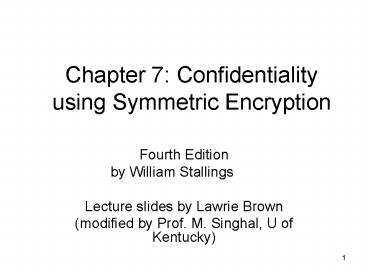Chapter 7: Confidentiality using Symmetric Encryption - PowerPoint PPT Presentation
1 / 21
Title:
Chapter 7: Confidentiality using Symmetric Encryption
Description:
traditionally symmetric encryption is used to provide message confidentiality. 3 ... noise, thermal noise in diodes, leaky capacitors, mercury discharge tubes etc ... – PowerPoint PPT presentation
Number of Views:234
Avg rating:3.0/5.0
Title: Chapter 7: Confidentiality using Symmetric Encryption
1
Chapter 7 Confidentiality using Symmetric
Encryption
- Fourth Edition
- by William Stallings
- Lecture slides by Lawrie Brown
- (modified by Prof. M. Singhal, U of Kentucky)
2
Introduction
- traditionally symmetric encryption is used to
provide message confidentiality
3
Placement of Encryption
- have two major placement alternatives
- link encryption
- encryption occurs independently on every link
- implies must decrypt traffic between links
- requires many devices, but paired keys
- end-to-end encryption
- encryption occurs between original source and
final destination - need devices at each end with shared keys
4
Placement of Encryption
5
Placement of Encryption
- when using end-to-end encryption must leave
headers in clear - so network can correctly route information
- hence although contents protected, traffic
pattern flows are not - ideally want both at once
- end-to-end protects data contents over entire
path and provides authentication - link protects traffic flows from monitoring
6
Placement of Encryption
- can place encryption function at various layers
in OSI Reference Model - link encryption occurs at layers 1 or 2
- end-to-end can occur at layers 3, 4, 6, 7
- as move higher less information is encrypted but
it is more secure though more complex with more
entities and keys
7
Encryption vs Protocol Level
8
Traffic Analysis
- is monitoring of communications flows between
parties - useful both in military commercial spheres
- can also be used to create a covert channel
- link encryption obscures header details
- but overall traffic volumes in networks and at
end-points is still visible - traffic padding can further obscure flows
- but at cost of continuous traffic
9
Key Distribution
- symmetric schemes require both parties to share a
common secret key - issue is how to securely distribute this key
- often secure system failure due to a break in the
key distribution scheme
10
Key Distribution
- given parties A and B have various key
distribution alternatives - A can select key and physically deliver to B
- third party can select deliver key to A B
- if A B have communicated previously can use
previous key to encrypt a new key - if A B have secure communications with a third
party C, C can relay key between A B
11
Key Hierarchy
- typically have a hierarchy of keys
- session key
- temporary key
- used for encryption of data between users
- for one logical session then discarded
- master key
- used to encrypt session keys
- shared by user key distribution center
12
Key Distribution Scenario
13
Key Distribution Issues
- hierarchies of KDCs required for large networks,
but must trust each other - session key lifetimes should be limited for
greater security - use of automatic key distribution on behalf of
users, but must trust system - use of decentralized key distribution
14
Random Numbers
- many uses of random numbers in cryptography
- nonces in authentication protocols to prevent
replay - session keys
- public key generation
- keystream for a one-time pad
- in all cases its critical that these values be
- statistically random, uniform distribution,
independent - unpredictability of future values from previous
values
15
Pseudorandom Number Generators (PRNGs)
- often use deterministic algorithmic techniques to
create random numbers - although are not truly random
- can pass many tests of randomness
- known as pseudorandom numbers
- created by Pseudorandom Number Generators
(PRNGs)
16
Linear CongruentialGenerator
- common iterative technique using
- Xn1 (aXn c) mod m
- given suitable values of parameters can produce a
long random-like sequence - suitable criteria to have are
- function generates a full-period
- generated sequence should appear random
- efficient implementation with 32-bit arithmetic
- note that an attacker can reconstruct sequence
given a small number of values - have possibilities for making this harder
17
Using Block Ciphers as PRNGs
- for cryptographic applications, can use a block
cipher to generate random numbers - often for creating session keys from master key
- Counter Mode
- Xi EKmi
18
ANSI X9.17 PRG
19
Blum Blum Shub Generator
- based on public key algorithms
- use least significant bit from iterative
equation - xi xi-12 mod n
- where np.q, and primes p,q3 mod 4
- Unpredictable (passes next-bit test)
- security rests on difficulty of factoring n
- is unpredictable given any run of bits
- slow, since very large numbers must be used
- too slow for cipher use, good for key generation
20
Natural Random Noise
- best source is natural randomness in real world
- find a regular but random event and monitor
- do generally need special h/w to do this
- eg. radiation counters, radio noise, audio noise,
thermal noise in diodes, leaky capacitors,
mercury discharge tubes etc - starting to see such h/w in new CPU's
- problems of bias or uneven distribution in signal
- have to compensate for this when sample and use
- best to only use a few noisiest bits from each
sample
21
Summary
- have considered
- use and placement of symmetric encryption to
protect confidentiality - need for good key distribution
- use of trusted third party KDCs
- random number generation issues































